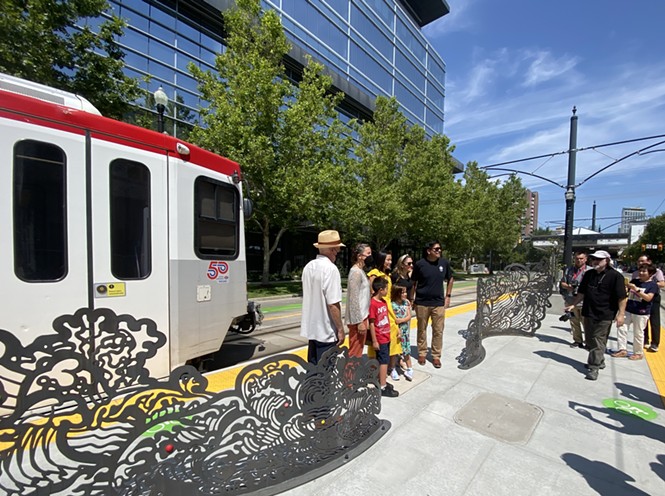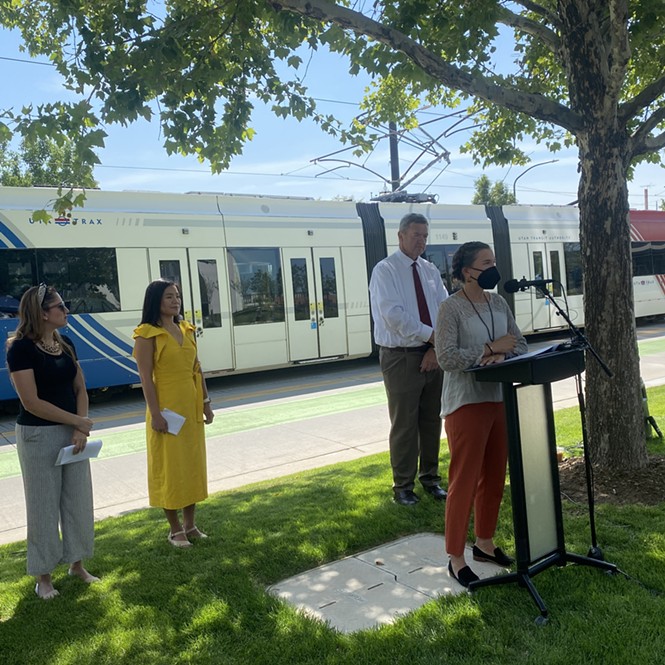
- Benjamin Wood
- "The Crossing," by artist Jiyoun Lee-Lodge, evokes the movement of water and greets transit riders at the new 600 South Station.
CENTRAL 9TH—Utah Transit Authority chairman Carlton Christensen said Tuesday that he feels a particular connection to the now-open TRAX station at 650 S. Main.
In 1997—when Christensen was a newly-elected member of the Salt Lake City Council—he toured the area with the director of the city’s Redevelopment Agency (RDA), who explained how space had been reserved along the rail lines for a future TRAX station “to be built in the near future.”
“Who would have thought that the ‘near future’ would be 25 years later?” Christensen said. “With every addition that you see in the UTA system, we offer more connection, more mobility and more access to opportunity. This station and all of our transit services are here for you.”

- Benjamin Wood
- Salt Lake City Mayor Erin Mendenhall poses for photographs with members of the City Council and artist Jiyoun Lee-Lodge and her family at the opening of the 600 South Station on Tuesday, July 26, 2022.
For passenger rail, those additions have been relatively few and far between since the initial flurry of transit construction that preceded Salt Lake City’s hosting of the 2002 Olympic Winter Games. The 900 South Station—on 200 West—was built in 2005, while the S-Line Streetcar opened in 2013.
Since then, UTA has made strides in modernizing its traditional bus services, implementing high-frequency routes in Salt Lake City and Bus Rapid Transit (BRT) lines elsewhere around the Wasatch Front.
Ana Valdemoros, who represents District 4 on the Salt Lake City Council, said the 600 South Station both reflects and will add to the southward and westward growth of the city’s urban core. Investing in multi-modal transportation, she said, ensures that residents have convenient and equitable access to the places they need to go.
“This station’s midtown location is key to so many Downtown-adjacent neighborhoods,” Valdemoros said. “Not only will it serve as a bridge to and from Downtown, but it will also ensure increased mobility for our city’s residents and workforce in the Ballpark, Central Ninth, Granary and Central City neighborhoods.
That sentiment was echoed by Matthew Behrmann, senior vice president of the Patrinely Group, whose firm is finalizing a new office tower built adjacent to the TRAX station. Patrinely Group was among the private entities that contributed funding to the station project and Behrmann said proximity to public transit was a key factor in deciding to launching the Salt Lake City development.
“It responds to what today’s most progressive and discerning employers desire in their office home—a healthy, productive and connected daily environment for their employees and their customers,” he said.

- Benjamin Wood
- (L-R) City Councilperson Ana Valdemoros, artist Jiyoun Lee-Lodge and UTA Chairman Carlton Christensen look on as Salt Lake City Erin Mendenhall speaks to the press at the opening of a new TRAX transit station at 650 S. Main St on Tuesday, July 26, 2022.
So will it take another 20-plus years until the next new TRAX station in Salt Lake City?
“Heck no!” Mayor Erin Mendenhall said. “We’re going hard after [light rail on] 400 West.”
Mendenhall said there are a number of potential transit projects in the city’s plans, which her administration is pushing to expedite with the benefit of federal transportation funding. The city has also seen a marked pivot toward public and active transportation in recent years, with projects underway to reprioritize pedestrians, cyclists and transit riders on 200 South, 900 South, 300 West and the corridors around—but notably not on—State Street.
“We are the fastest-growing state in the nation, with the strongest economy, and when it comes down to city vision, it's about how we grow,” Mendenhall said. “We’re trying to get the most good out of the growth that’s happening here.”
Beginning this fall, school-age Salt Lake City residents will be able to ride transit for free through a program funded by the City Council in partnership with the Salt Lake Education Foundation. With TRAX expansion and free fare initiatives, Mendenhall said the city is aiming to make transit a viable, low-cost option for residents who are facing a mountain cost-of-living crisis.
“We know the two factors to compel current drivers to take transit instead are convenience and affordability,” Mendenhall said. But we have an opportunity with our young population, who are not yet drivers or just beginning to drive, to build transit into their way of life.”
UTA waived fares systemwide during the month of February, part of a city-led effort to improve air quality during the winter inversion, and saw ridership numbers surge as a result. Since then, Gov. Spencer Cox has repeatedly floated free transit as a potential response to inflation, though legislative leaders have resisted those calls.
Christensen said that UTA is currently studying the holistic impact of free fares and suggested that more short-term promotions, like Free Fare February, could be on the horizon. But he added that the agency is making a point to be thorough, as it's far easier to make something free than to impose a charge on what previously cost nothing.
“Once you go down that road, it’s hard to peel it back,” he said.
There are no immediate plans to build additional rail stations, but Christensen suggested it would not be another decadeslong wait for the next expansion. Cities are increasingly adopting transit-oriented building codes—typically denser, more urban-minded developments—around bus and train routes, which boosts the use of and demands on the transit network.
“Our average customer is 34 years old,” Christensen said. “It’s changing from what I would term as a commuting population to one that’s using [transit] as part of their lifestyle. In fact, some of our largest growth is on the weekends and, in particular, Sunday service.”